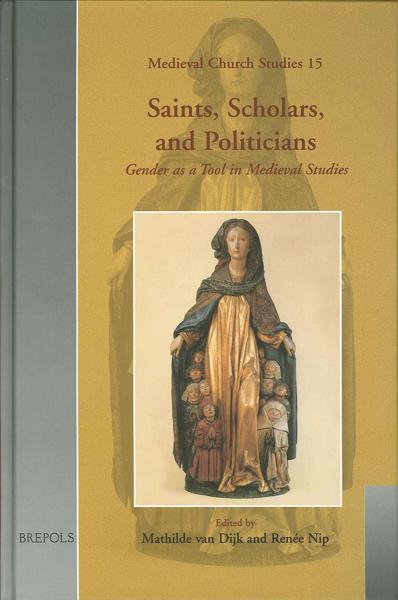
Envisioning the Bishop
Images and the Episcopacy in the Middle Ages
Sigrid Danielson, Evan A. Gatti (eds)
- Pages: xx + 452 p.
- Size:156 x 234 mm
- Illustrations:45 b/w, 7 col.
- Language(s):English
- Publication Year:2014
- € 130,00 EXCL. VAT RETAIL PRICE
- ISBN: 978-2-503-54799-2
- Hardback
- Available
- € 130,00 EXCL. VAT RETAIL PRICE
- ISBN: 978-2-503-55260-6
- E-book
- Available
An interdisciplinary anthology that explores the role of imagery, both visual and textual, in the construction of episcopal authority from the late-antique period through the fourteenth century.
"Envisioning the Bishop is a well-crafted collection of articles centered on images of medieval bishops. The articles are extremely wide-ranging, both chronologically and geographically, with offerings from all parts of Europe between the 4th and the 13th centuries. Despite this broad range the articles complement one another beautifully, thanks not only to their careful selection, but also to the editors' useful introduction which introduces the reader to the recent historiography on the topic and suggests ways in which the present essays tie together." (Jean A. Truax, in: Sehepunkte, 14 (2014), Nr. 9 [15.09.2014], www.sehepunkte.de/2014/09/24933.html)
"Reames' Ergebnis, dass es offensichtlich schwer war, einen dauerhaften Konsens darüber zu finden, wie ein idealer Bischof sein sollte (S. 327), kann grundsätzlich als Fazit des gesamten Bandes herangezogen werden. Es gab in synchroner Perspektive divergierende und sich teils widersprechende Bilder vom Bischof, die zudem jeweils einem Wandel unterworfen waren. Angesichts des Facettenreichtums des mittelalterlichen Bischofs und des großen Untersuchungszeitraumes wundert dieser Befund nicht. Dass der Band dennoch anregend zu lesen ist, liegt nicht zuletzt an der durchweg hohen Qualität der Beiträge und der darin erzielten Einzelerkenntnisse. Durch die thematische Fokussierung auf die Vorstellungen vom Bischof korrespondieren die Beiträge zudem sehr gut miteinander und spiegeln die Vielfalt und den Wandel der Bischofsideale und -bilder in angemessener Weise wider." (Dominik Waßenhoven, in: H-Soz-Kult, 04.02.2015, http://www.hsozkult.de/publicationreview/id/rezbuecher-23014)
“The collection includes excellent scholarly works from different disciplines such as literature, architecture, art history, and history on bishops during the Middle Ages.” (Christine Kleinjung, in The Catholic Historical Review, 102/2, 2016, p. 377-378)
“Alla bidrag speglar, med rätta, problemet med att definiera vad en idealbiskop var, även vid samma tidsperiod, och de representerar ett försök till att problematisera och lyfta fram detta. Således bidrar denna volym med nya inblickar i den kulturella historien om den medeltida biskopen. Som avslutningskapitlet understryker: “images matter” .” (Sara E. Ellis Nilsson, in Kyrkohistorisk årsskrift, 2016, p. 155)
“Der Band bietet eine beeindruckende Sammlung vielfältigster Fallstudien zur Entstehung und Wirkmächtigkeit von Bischofs-Bildern allgemein und leistet einen inspirierenden Beitrag zur historischen Anthropologie des Bischofsamtes im Mittelalter.” (Tanja Skambraks, Rottenburger Jahrbuch für Kirchengeschichte, 35, 2016, Seite 314)
« (…) ouvrage très stimulant (…) il s’agit d’un ensemble d’études ouvrant nombre de réflexions. » (Véronique Julerot, dans Revue Mabillon, 27, 2016, p. 359-360)
The bishop wielded significant authority in religious, intellectual, and political spheres during the Middle Ages, but how was this influence articulated, and once articulated, how was it received? The essays in this volume represent a variety of disciplinary perspectives, each tuned to the production of images made by, for, and about the medieval episcopacy. They present the bishop as a model of piety and intellectual life as well as political and religious action.
Considering material from Late Antiquity through the thirteenth century, the essays offer a series of case-studies demonstrating that crafting episcopal imagery was a complicated endeavour employing pictorial, historical, literary, and historiographic devices. Never a static institution, the episcopacy was formed and reformed making it visible to the bishop, to those with whom he interacted, and to broader communities. These efforts at making present the power and authorities of the office asserted the duties, expectations, and ideals of the bishop in ways often specific to time and place.
The diverse perspectives on the episcopal image assembled here reveal the office, not as a singular contour, but as a succession of marks and erasures. Shaped by supporters and detractors alike, medieval images of the bishop engaged with historical models, responded to present realities, and considered the eschatological future.




